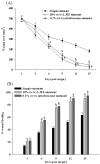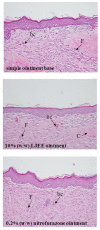Wound repair and anti-inflammatory potential of Lonicera japonica in excision wound-induced rats
- PMID: 23173654
- PMCID: PMC3577469
- DOI: 10.1186/1472-6882-12-226
Wound repair and anti-inflammatory potential of Lonicera japonica in excision wound-induced rats
Abstract
Background: Lonicera japonica Thunb. (Caprifoliaceae), a widely used traditional Chinese medicinal plant, is used to treat some infectious diseases and it may have uses as a healthy food and applications in cosmetics and as an ornamental groundcover. The ethanol extract of the flowering aerial parts of L. japonica (LJEE) was investigated for its healing efficiency in a rat excision wound model.
Methods: Excision wounds were inflicted upon three groups of eight rats each. Healing was assessed by the rate of wound contraction in skin wound sites in rats treated with simple ointment base, 10% (w/w) LJEE ointment, or the reference standard drug, 0.2% (w/w) nitrofurazone ointment. The effects of LJEE on the contents of hydroxyproline and hexosamine during healing were estimated. The antimicrobial activity of LJEE against microorganisms was also assessed. The in vivo anti-inflammatory activity of LJEE was investigated to understand the mechanism of wound healing.
Results: LJEE exhibited significant antimicrobial activity against Staphylococcus aureus, Staphylococcus epidermidis, Escherichia coli, Candida albicans, and Candida tropicalis. The ointment formulation prepared with 10% (w/w) LJEE exhibited potent wound healing capacity as evidenced by the wound contraction in the excision wound model. The contents of hydroxyproline and hexosamine also correlated with the observed healing pattern. These findings were supported by the histopathological characteristics of healed wound sections, as greater tissue regeneration, more fibroblasts, and angiogenesis were observed in the 10% (w/w) LJEE ointment-treated group. The results also indicated that LJEE possesses potent anti-inflammatory activity, as it enhanced the production of anti-inflammatory cytokines that suppress proinflammatory cytokine production.
Conclusions: The results suggest that the antimicrobial and anti-inflammatory activities of LJEE act synergistically to accelerate wound repair.
Figures




Similar articles
-
In vivo antioxidative property, antimicrobial and wound healing activity of flower extracts of Pyrostegia venusta (Ker Gawl) Miers.J Ethnopharmacol. 2012 Mar 6;140(1):186-92. doi: 10.1016/j.jep.2012.01.008. Epub 2012 Jan 14. J Ethnopharmacol. 2012. PMID: 22265749
-
Wound healing properties, antimicrobial and antioxidant activities of Salvia kronenburgii Rech. f. and Salvia euphratica Montbret, Aucher & Rech. f. var. euphratica on excision and incision wound models in diabetic rats.Biomed Pharmacother. 2019 Mar;111:1260-1276. doi: 10.1016/j.biopha.2019.01.038. Epub 2019 Jan 15. Biomed Pharmacother. 2019. PMID: 30841440
-
Struthanthus vulgaris ointment prevents an over expression of inflammatory response and accelerates the cutaneous wound healing.J Ethnopharmacol. 2016 Aug 22;190:319-27. doi: 10.1016/j.jep.2016.06.050. Epub 2016 Jun 18. J Ethnopharmacol. 2016. PMID: 27329781
-
Systematic review of Ethiopian medicinal plants used for their anti-inflammatory and wound healing activities.J Ethnopharmacol. 2021 Aug 10;276:114179. doi: 10.1016/j.jep.2021.114179. Epub 2021 May 11. J Ethnopharmacol. 2021. PMID: 33989738
-
Ferulic Acid: A Review of Mechanisms of Action, Absorption, Toxicology, Application on Wound Healing.Antiinflamm Antiallergy Agents Med Chem. 2024;23(4):205-214. doi: 10.2174/0118715230309592240723105514. Antiinflamm Antiallergy Agents Med Chem. 2024. PMID: 39108119 Review.
Cited by
-
Reducing Acneiform Rash Induced by EGFR Inhibitors With Honeysuckle Therapy: A Prospective, Randomized, Controlled Study.Front Pharmacol. 2022 Feb 18;13:835166. doi: 10.3389/fphar.2022.835166. eCollection 2022. Front Pharmacol. 2022. PMID: 35250582 Free PMC article.
-
Lonicera japonica THUNB. Extract Inhibits Lipopolysaccharide-Stimulated Inflammatory Responses by Suppressing NF-κB Signaling in BV-2 Microglial Cells.J Med Food. 2015 Jul;18(7):762-75. doi: 10.1089/jmf.2014.3341. Epub 2015 Apr 21. J Med Food. 2015. PMID: 25897683 Free PMC article.
-
In Vivo Anti-Candida Activity of Phenolic Extracts and Compounds: Future Perspectives Focusing on Effective Clinical Interventions.Biomed Res Int. 2015;2015:247382. doi: 10.1155/2015/247382. Epub 2015 Aug 24. Biomed Res Int. 2015. PMID: 26380266 Free PMC article. Review.
-
Effect of methionine hydroxy analog feed supplements: Significant alteration and enrichment of rumen microbiota and metabolome in Hu sheep.Front Vet Sci. 2022 Oct 26;9:999726. doi: 10.3389/fvets.2022.999726. eCollection 2022. Front Vet Sci. 2022. PMID: 36387392 Free PMC article.
-
Lonicerae Japonicae Flos and Lonicerae Flos: A Systematic Pharmacology Review.Evid Based Complement Alternat Med. 2015;2015:905063. doi: 10.1155/2015/905063. Epub 2015 Jul 16. Evid Based Complement Alternat Med. 2015. PMID: 26257818 Free PMC article. Review.
References
Publication types
MeSH terms
Substances
LinkOut - more resources
Full Text Sources
Other Literature Sources
Medical

